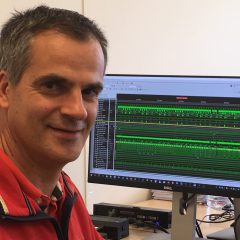What animated your interest in IC design ?
I’ve always been attracted by technology making life easier and more fun. Amazed by the creative power of electronics and its broad applications, I played with electronics as a teenager, and naturally became a designer in microelectronics few years after. Three decades later, I still enjoy working in this profession, sharing this passion with a design-team.
When IC-designing, I very much like creating and taking up sharp technical challenges that make product better fit customer needs and even more competitive. Besides, to reach this goal, I’m very keen on dealing with complex design-tools and design functionalities, making the most of them to improve IC performances.I consider IC-design and microelectronic fabric pretty much like the art of mastering the physics of the electron.
It’s a great example of an incredible, difficult and subtle human adventure “Man vs. Nature”.
The power of human intelligence seems limitless, but nobody can cheat playing with the rules of physics.
Everyone in the design-team has to feel responsible of every detail among millions. A single neglected technical detail can ruin the design effort of the full team, requiring another nanometric fabric processing cycle at huge cost.
This is what makes IC-designing a fabulous school of humility: whatever the experience level you have, you’ve got to always learn, always accept to carry out self-examination vs. physics.
I like it a lot.What was the last functional block you worked on ?
I recently designed a calibration controller using digital techniques. The main goal of this function is to correct dynamically small analog design flaws, and boost IC technical performances in order to have a more competitive product. I enjoyed very much this challenge because it’s a great co-design example of digital serving analog expertise leveraging together the performances of the IC.
This key-element of the final application allows enhanced performance for the customer end product. Being a contributor in this challenging innovation process is highly exciting.Why have you chosen to join SCALINX ?
I strongly believe that professional success key-point is firmly linked to mutual trust and direct communication within the design-team. When I realized some old fellow designers were already part of the SCALINX, I joined the team right away, happy to share the same IC-design passion with the team and transmit my experience to the juniors.
Being more confident in what we can deliver as a team-work, aware of the solid experience in ICs development up to industrial product we can bring altogether, made me jump into SCALINX adventure !What makes SCALINX stand out as an employer ?
I’m convinced that diversity is a rich and winning value in every human enterprise.
SCALINX grows up this point of view, developing an excellent working synergy between employees. As a matter of fact, international talents already work together well, as well as juniors and seniors, and all complementary design-skills like: architects vs. designers, analog vs. digital designers, project technical manager vs. design-team.
In SCALINX, there is already this precious working culture of bridging the gaps where natural barriers exist due to sharp technical expertise or cultural boundaries. I really enjoy contributing to make this happen and I’m quite sure SCALINX product success will sand out of this positive culture.I think SCALINX recruitment really makes the difference by fulfilling most of the employee constraints.
What is your typical day at work ?
My day at work looks typical from the outside but never from the inside.
Most of the day, I’m sitting at my double-screen workstation in the open-space share with colleagues. This office layout allow us to mutually exchange each others information and technical point of views. I consider that important to act as a real team-player in our way of working.
As the project-team works in multi-sites, I never hesitate to use also remote chatting or tele-conferences for technical reviews or points to share.
What happens inside my workstation deals with different design-steps and design-tools:
Architecture a digital function, code it in high-level language, simulate to verify it, synthesize it with library elements, and process all different steps of physical implementation.
Running this design process is exciting because it’s full of various steps and different everyday technical challenges. These challenges may impact the work of other designers and require other design iteration until fully validated.
Typical day may be, but absolutely not routine.How do you spend your time outside working hours ?
Actually, I’m a lucky designer living by the seaside in Normandy. So most of the time, I try to take benefit of it during out-of-office hours. On water, I practice leisure sailing and windsurfing in a club, and by the beach I like hiking, jogging, and biking from time to time. Enjoying both fitness and social contact, I’m seeking to share these various outdoor activities with friends or sport enthusiasts.
Occasionally I also help out with sound engineering for a kids choir performing live in my village.
The rest of the time, when I have no other good excuse than practicing my favorite water-sport, I’ve got to do my home-work like a bit of gardening maintenance.
That’s all my way of stressing away after work.

